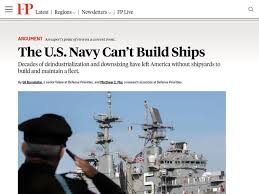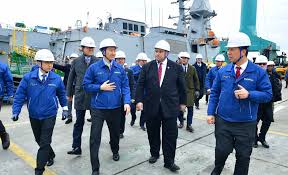President Trump: pins hopes on Korean shipbuilding
– Three-year delays in nine US shipbuilding projects
– Korea named as partner for US shipbuilding
Summary from Hankyoreh newspaper article.

President Trump’s speech: Washington Congress
On March 4, 2025, President Trump spoke at a joint session of the House and Senate in Washington Congress.
He named Korea as a key partner in reviving the US shipbuilding industry.
1. The Trump administration will create the Bureau of Shipbuilding as an intergovernmental working-level consultation body for the first time.
2. The only industry in Korea that is expected to grow is the Korean shipbuilding industry.
South Korea’s Minister of Trade, Industry and Energy: Ahn Deok-keun:
US Secretary of Commerce Lutnick is extremely determined to lead the Bureau of Shipbuilding and the working-level consultation body.
1. Hanwha has acquired the Philadelphia Shipyards.
2. South Korea is considering measures to strengthen US shipyards. The real names of Korean companies were mentioned.

Many delays in construction of US escort ships:
In January 2024, the delivery of an escort ship to the US Navy at Fincantieri Shipyard was delayed.
1. The results of the investigation into the construction delays are worse than expected.
2. Nine construction projects have been delayed by up to three years.
The Trump administration wants to use Korea to revive the US shipbuilding industry.

US shipbuilding industry in decline: only three warship yards
1. There used to be 414 shipyards operating in the US.
2. However, most shipyards have now disappeared, with only government orders.
The only shipyards capable of building in the US are General Dynamics, Huntington Ingalls, and Fincantieri.

The US requests cooperation from Korean shipbuilding:
The reason for sending a love call to Korea is for the security of the US.
That is why the US Navy visited Korea HD Hyundai Heavy Industries and Hanwha Ocean in 2024.
Enactment of the Jones Act:
In 1920, the US enacted the Jones Act, which states that “only ships built in the US can carry out coastal shipping.”
In the future, advanced technological support from Korea and Japan will be essential to build ships in the US.
Enactment of the Barnes-Tripson Act:
In the 1960s, the Barnes-Tripson Act protected the US shipbuilding industry by making warships in the US.
However, the US Navy is unable to receive support for its recovery from its allies, Japan and South Korea.
US shipyard infrastructure optimization plan: a series of failures:
2018: The US Navy will invest $21 billion over the next 20 years to renovate four shipyards belonging to the Navy.
2022: $19.6 million in subsidies was provided to 24 US shipyards to support private shipyards.
In the US, where labor costs are high, it was impossible to “revive the labor-intensive shipbuilding industry.”

China’s shipbuilding industry expands rapidly: “China Military Power Assessment Report”:
The Chinese Navy has the world’s largest number of ships, and the gap has gradually widened since then.
1. 2000: The US had an overwhelming lead with 318 ships and China with 110.
2. 2024: China has 234 ships, while the US has 219.
3. 2030: China has 460 ships and the US has 260 ships, creating a gap of 200 ships.
![[Photo = Yonhap News]](https://wimg.mk.co.kr/news/cms/202502/12/news-p.v1.20250212.2a5942148af84e689634e93ff019c903_P1.png)
Weakening of US naval power: “Naval Readiness Assurance Act” proposed:
This bill states that “the US can outsource construction to countries with mutual defense treaties and NATO.”
1. The US Congress is pushing ahead with a legal amendment to allow allies to build warships.
2. Republican Senator Curtis and others have proposed the Naval Readiness Assurance Act.
NATO does not have a large shipbuilding company. The only foreign shipbuilding companies capable of building warships are in South Korea and Japan.
South Korea’s strategy for conquering US shipbuilding:
In 2024, Hanwha Ocean acquired the Philly Shipyard in the US for about $100 million.
1. It is said that the cost of dock modification is equivalent to the acquisition price.
2. However, local labor costs are high, and shipbuilding equipment will also need to be airlifted from Mexico.
Hanwha Ocean is considering “building blocks at Geoje Shipyard in South Gyeongsang Province and exporting them to the US.”
Shipbuilding technology needed by the Trump administration:
The Trump administration is pushing to secure leadership in the large-scale commercial ship market.
1. Not only warships, but LNG projects are also in the domain of shipbuilding companies.
2. It is doubtful whether the US and South Korea can work together to produce good results.
https://news.yahoo.co.jp/articles/dff7bf6fa30e0702ceca5d9394a3a5f9583b89d1
Internet user opinions: List
A. Japan and South Korea have backlogs for the next three years:
Neither Japan, South Korea, nor China can afford to accept new shipbuilding orders.
1. Japan’s backlog for new shipbuilding orders is filled up for the next three years.
2. China and South Korea also have backlogs for new orders worth 4.3 years.
The US wants to revive abandoned shipyards. But that’s impossible.

B. The Trump Administration’s Intentions: Korea Beware:
US shipbuilding only has warships ordered by the US government, and delays in work have become commonplace.
1. They absorb the latest know-how from Korean shipbuilding, and later say that “warship construction belongs to American companies.”
2. When Korea starts to complain, they bring up the reduction of US forces in Korea, withdrawal of US troops, and tariffs.

C. Preventing leaks of US military secrets: Korea’s safety and reliability:
Trump has been harshly critical of Korea’s leaks of classified information.
Construction of US warships: Treated as top secret
1. If it were a tanker or cargo ship, the shipbuilding technology would simply be leaked to Korea.
2. However, warships are a mass of classified information, and they cannot be commissioned to Korea.